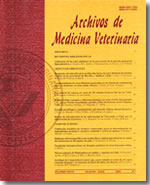Efectos de la compresión de la médula espinal inducida artificialmente sobre el plexo venoso vertebral interno cervical en el perro: evaluación comparativa mediante venografia por tomografía computarizada y venografia por substracción digital
Contenido principal del artículo
Resumen
El plexo venoso vertebral interno (PVVI) es una red vascular localizada a lo largo del canal vertebral. El presente estudio fue diseñado para evaluar variaciones en la morfología del PVVI cervical bajo condiciones de compresión aguda de la médula espinal en perros. Una compresión medular experimental fue inducida en once perros adultos al nivel de C3/4 utilizando una técnica modificada de catéter de angioplastia con balón. Los perros fueron evaluados antes, durante y posterior a la compresión medular utilizando para ello venografia intraósea por substracción digital (VSD) y venografia por tomografía computarizada (TC). La VSD mostró pérdida manifiesta e inmediata de opacificación del PVVI cervical en el sitio de la compresión. La venografia por TC también evidenció pérdida de llenado del PVVI cervical con medio de contraste en las áreas comprimidas por el balón de angioplastia. La VSD también mostró cambios hemodinámicos del PVVI y sus ramas colaterales durante la compresión. Durante la postcompresión las imágenes de la VSD y la venografia por TC revelaron que algunos perros presentaban pérdida de llenado con medio de contraste del PVVI cervical en el área previamente comprimida. Los resultados de este estudio muestran que la compresión medular experimental en perros induce alteraciones locales inmediatas en la morfología venosa dentro del canal vertebral afectado.

